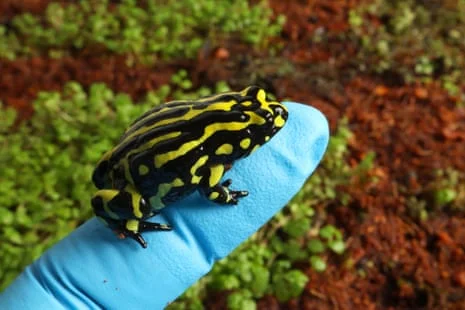
Sequencing the Southern Corroboree Frog: A Hope for Recovery
In a remarkable scientific advancement, researchers have successfully sequenced the genome of the critically endangered southern corroboree frog, known for its distinct yellow and black markings. This tiny amphibian is a striking representation of Australia’s unique biodiversity, yet it is on the brink of extinction due to disease and habitat degradation exacerbated by climate change. Such genomic research not only offers a beacon of hope for the species but also underscores the importance of addressing broader environmental challenges.
The southern corroboree frog, residing in the temporary pools and peat bogs of Kosciuszko National Park in New South Wales, has been dubbed "functionally extinct." With a genome three times the size of a human's and one of the largest known for any frog, this species is uniquely adapted but also vulnerable. Dr. Tiffany Kosch from the University of Melbourne, the lead author of the study published in Wellcome Open Research, remarked, "They’re quite unique frogs... they belong to this ancient family that’s only found in Australia," highlighting their evolutionary significance.
The genome sequencing effort was no small feat; it took an entire decade of meticulous work, with frog tissues transported to New York for analysis under strict conditions. The data collected is a critical resource that could potentially lead to understanding why this species is so susceptible to the deadly chytrid fungus, a leading cause of amphibian decline globally. As Dr. Kosch states, "The hope is that work with the southern corroboree frog could be used as a proof-of-concept for other frogs threatened by the chytrid fungus, and potentially other species threatened by climate change." This perspective lends the research potential not just for the corroboree frog, but for many struggling amphibians worldwide.
Experts in conservation ecology, like Dr. Simon Clulow from the University of Canberra, stress the importance of this research. He explained that having the complete genome enables better understanding and responses to species' challenges, particularly the invasive chytrid fungus affecting frogs across the globe. The mapping of the genome could help identify resistant genetic traits, paving the way for targeted conservation strategies.
Prof. Nicki Mitchell from the University of Western Australia adds a cautious note, indicating that while this genomic research is a priority for Australian amphibians, particularly the southern corroboree frog, many other species remain in urgent need of attention—2,200 species are officially listed as threatened under Australia's Environment Protection and Biodiversity Conservation Act. As she succinctly stated, the funding dedicated to biodiversity is "minuscule compared to what we need," calling for increased investment to combat climate and biodiversity crises.
As we delve into the future of amphibian conservation, the sequencing of the southern corroboree frog's genome represents both a critical step and a symbolic fight against the pressing issues of climate change and biodiversity loss. Will this groundbreaking research inspire similar initiatives for other endangered species? We invite your thoughts and comments on the significance of such scientific endeavors.